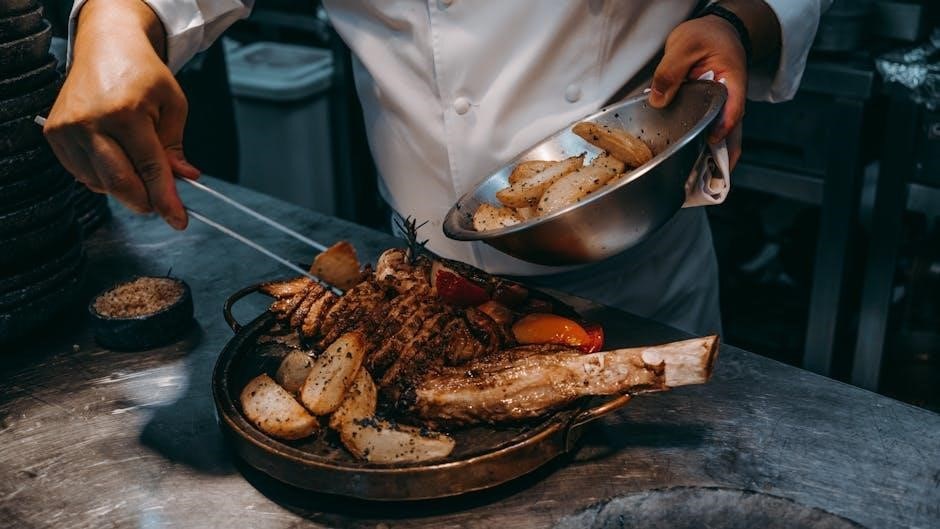
meat cutting instructions beef
Welcome to the world of beef cutting, where precision and skill transform raw meat into delicious, versatile dishes. Proper techniques ensure quality, safety, and optimal flavor.
1.1 Importance of Proper Beef Cutting
Proper beef cutting is essential for ensuring safety, quality, and consistency. It guarantees even cooking, reduces waste, and enhances the dining experience. Correct techniques prevent contamination and maintain the meat’s tenderness and flavor. Properly cut beef also allows for precise portion control, which is crucial for both home cooks and professional chefs. Moreover, it ensures that each cut meets food safety standards, preventing potential health risks. By following precise cutting instructions, you achieve uniform results, making every meal enjoyable and satisfying. This step is fundamental for maximizing the value of your beef purchase.
1.2 Overview of Beef Cutting Process
The beef cutting process involves several systematic steps to transform a whole carcass into usable cuts. It begins with primal cuts, dividing the beef into large sections like the chuck, loin, and round. Next, these primals are further broken down into sub-primals and eventually into retail cuts such as steaks, roasts, and ground beef. Each step requires precision to ensure uniformity and quality. Proper tools and techniques are essential, from sharp knives to safe handling practices. The process also includes trimming excess fat and marking cuts for consistency. This structured approach ensures efficiency and maximizes the value of the beef.

Essential Tools for Beef Cutting
Sharp knives, sturdy cutting boards, and protective gear are vital for safe and efficient beef cutting. These tools ensure precision and prevent accidents during the process.
2.1 Sharp Knives and Their Types
A sharp knife is indispensable for precise beef cutting. Common types include the chef’s knife, boning knife, and cleaver. The chef’s knife excels at slicing, while the boning knife removes bones effortlessly. Cleavers handle tough tasks like chopping bones. Sharpness ensures clean cuts and safety, preventing accidents. Dull knives tear meat, making the process inefficient. Regular honing maintains edge sharpness, while proper storage prevents dulling. Investing in quality knives enhances both the efficiency and safety of your beef-cutting experience, ensuring professional-grade results every time.
2.2 Cutting Boards and Safety Gear
A sturdy cutting board is essential for beef cutting, providing a clean, stable surface. Wooden or plastic boards are ideal, as they resist damage and maintain hygiene. Sanitize boards with soap and hot water after use to prevent contamination. Safety gear, such as cut-resistant gloves, protects hands from accidental cuts. Protective eyewear is recommended when using sharp tools like meat saws or cleavers. A well-prepared workspace ensures efficiency and safety, making the beef-cutting process both enjoyable and professional. Proper gear prevents accidents and maintains high standards of meat handling and preparation.
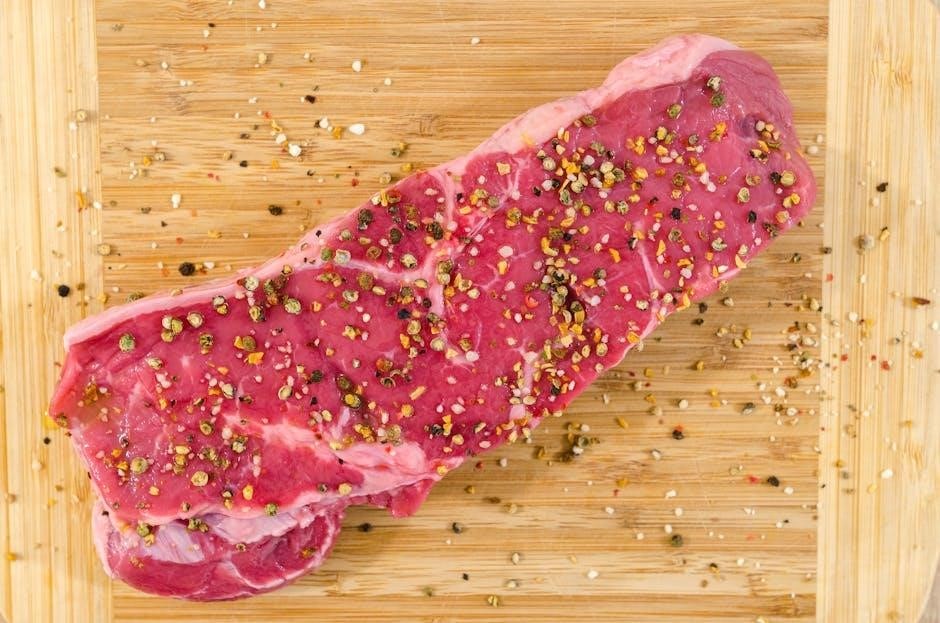
Basic Beef Cutting Techniques
Mastering basic beef cutting techniques is essential for achieving precision and efficiency. These skills ensure meat is handled safely, maintaining quality and consistency in every cut, ensuring optimal results.
3.1 Identifying the Grain of the Meat
Identifying the grain of the meat is crucial for tender and even cuts. The grain refers to the direction in which muscle fibers align. To determine the grain, look for visible lines or striations on the meat’s surface. Cutting against the grain ensures tenderness, as it shortens the muscle fibers, making the meat easier to chew. Always slice perpendicular to the grain for steaks and roasts to achieve the best texture and flavor. This technique is fundamental for any beef cutting process.
3.2 Trimming Fat and Connective Tissue
Trimming fat and connective tissue is essential for achieving high-quality beef cuts. Excess fat can lead to uneven cooking and a greasy texture, while connective tissue makes meat tough. Use a sharp knife to carefully remove visible fat layers and sinew, ensuring a clean cut. Proper trimming enhances tenderness and flavor. However, avoid over-trimming, as some fat is necessary for juiciness and texture. Balancing fat removal with retention is key to optimal results. This step ensures your beef is both palatable and visually appealing.
3.3 Marking Cuts for Consistency
Marking cuts ensures uniformity in portion size and thickness, crucial for even cooking. Use a guide or template to define clear boundaries for steaks, roasts, and ground beef. Consistent cuts enhance presentation and customer satisfaction. For steaks, mark thickness precisely, while for roasts, note weight and dimensions. Proper marking also aids in portion control, ensuring each cut meets quality standards. This step is vital for achieving professional results and maintaining consistency across all beef products. Clear markings guide the cutting process, ensuring accuracy and efficiency for both novice and experienced cutters alike.
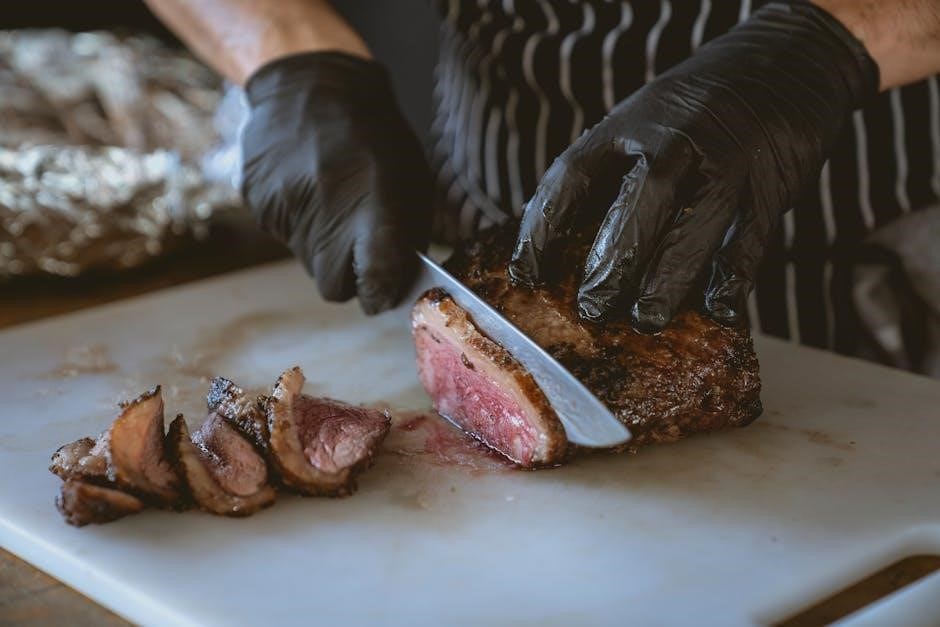
Understanding Beef Cuts
Beef cuts vary from primal sections to retail portions. Each cut offers unique flavors and textures, suited for specific cooking methods. Understanding them enhances culinary versatility and satisfaction.
4.1 Primal Cuts of Beef
The primal cuts of beef are the foundational divisions of the carcass. These include the chuck, rib, loin, round, flank, short plate, brisket, and shank. Each primal cut is then further divided into sub-primals and retail cuts. The primal cuts determine the texture and flavor of the final product, with the chuck offering hearty roasts and the loin providing tender steaks. Understanding primal cuts is essential for selecting the right meat for specific dishes and ensuring optimal cooking results. Proper identification and handling of these cuts are key to maximizing flavor and tenderness.
4.2 Retail Cuts and Their Uses
Retail cuts of beef are the final products available to consumers. These cuts are derived from the primal sections and vary in tenderness and flavor. Common retail cuts include steaks (e.g., ribeye, sirloin), roasts (e.g., chuck, round), and ground beef. Steaks are ideal for grilling or pan-frying, while roasts are perfect for slow-cooking methods like braising. Ground beef is versatile, used in dishes like burgers and meatloaf. Each cut has specific cooking recommendations, ensuring the best culinary experience. Understanding retail cuts helps home cooks and chefs select the right meat for their recipes, enhancing both texture and flavor in various dishes.
4.3 Ground Beef and Its Applications
Ground beef is a versatile and widely used product, offering flexibility in various dishes. It is typically made from trimmings of primal cuts like chuck or round. Common applications include burgers, meatloaf, tacos, and sauces. The lean-to-fat ratio can be customized, with standard options like 70/30 or 80/20. Ground beef is also used in casseroles, meatballs, and stuffed dishes. Proper handling ensures food safety, and seasoning enhances flavor. Its adaptability makes it a staple in many cuisines, providing endless opportunities for creative cooking while maintaining affordability and convenience. Ground beef is a key component in both traditional and modern recipes.
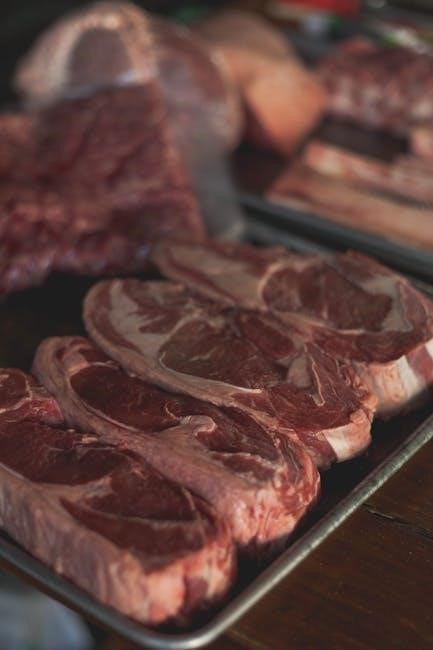
Cutting Instructions for Specific Cuts
Specific cuts like steaks, roasts, and brisket require precise instructions. Steaks are portioned by thickness, while roasts are sized by weight for even cooking. Brisket needs careful trimming. Customization enhances results.
5.1 Steaks: Thickness and Portioning
Steak thickness and portioning are critical for consistent results. A standard thickness of 3/4 inch is recommended for even cooking. Thicker steaks retain juiciness, while thinner ones cook faster. Portion sizes vary, but 6-8 ounces per serving is typical. Ribeye and sirloin steaks are often cut thicker for tenderness, while flank steaks may be thinner. Customization allows for personal preference, such as extra-thick cuts for special occasions or uniform portions for large gatherings. Proper portioning ensures every steak cooks evenly, enhancing both flavor and presentation.
5.2 Roasts: Size and Weight Guidelines
Roast size and weight are tailored to meet specific needs. Roasts are typically cut into 1 per package, with sizes varying based on the beef’s overall size. Brisket size, for instance, can differ significantly. Chuck roasts are often 2-4 pounds, ideal for family meals, while round roasts may be smaller and leaner. Larger roasts are perfect for feeding crowds, while smaller ones suit fewer servings. Customization is key; some prefer bone-in roasts for added flavor. Clear guidelines ensure roasts are cut to desired specifications, balancing quality and portion control effectively.
5.3 Brisket: Cutting and Preparation
Brisket is a popular cut of beef, known for its rich flavor and tender texture when properly prepared. Brisket size varies significantly based on the beef’s overall size. A whole brisket can be cut into 2 chunks if you’re getting a half beef. For a quarter beef, you’ll receive your share in 1 chunk. Proper cutting involves trimming excess fat and ensuring even portions. Brisket can be roasted, smoked, or braised. Shred and mix with BBQ sauce for a delicious meal. Follow package instructions for heating pre-cooked brisket. Customization ensures the best results for your desired recipe.
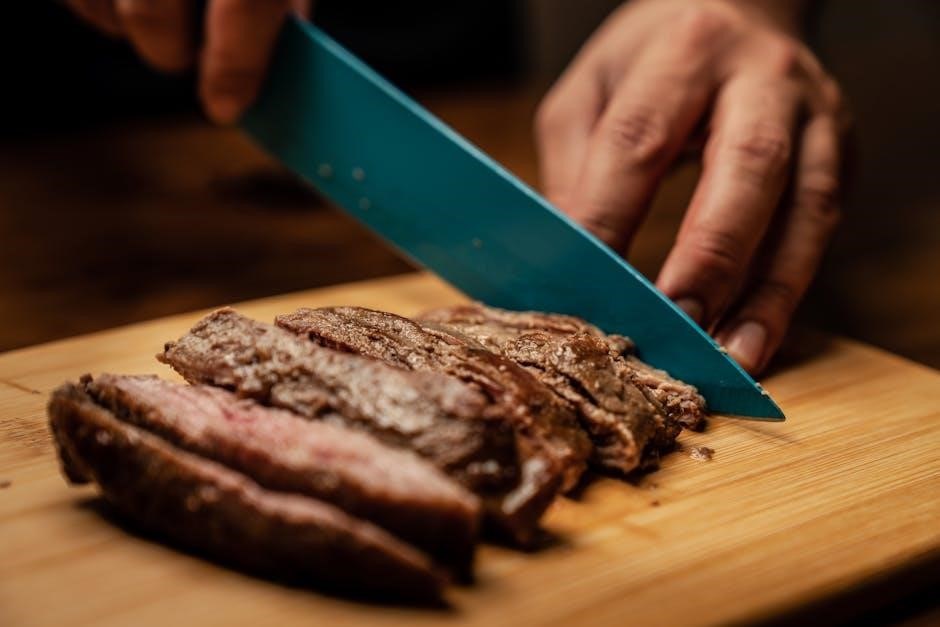
Customizing Your Beef Cuts
Customizing beef cuts allows for tailored preferences, enhancing flavor and usability. Choose steak thickness, roast size, and fat ratios to suit recipes and dietary needs effectively.
6.1 Choosing Steak Thickness
Choosing the right steak thickness is crucial for achieving desired texture and flavor. Standard thickness ranges from 1 to 1.5 inches, with 1 inch being ideal for most dishes. Thicker steaks (1.25–1.5 inches) are perfect for grilling or pan-frying, ensuring a juicy interior and caramelized crust. Thin steaks (0.75–1 inch) cook quickly and are great for stir-fries or sandwiches. Consider personal preference, cooking method, and recipe requirements when selecting thickness. Consistent portioning ensures even cooking and enhances dining satisfaction. Proper thickness also impacts marbling distribution, affecting overall flavor and tenderness.
6.2 Selecting Roast Size and Weight
Selecting the right roast size and weight ensures optimal flavor and portion control. Roasts vary in size, from small 2-pound options for intimate meals to large 10-pound cuts for special occasions. Consider the number of servings needed, with a general guideline of 6-8 ounces per person. For example, a 3-pound roast serves 4-6 people, while a 5-pound roast accommodates 8-10. Choose bone-in roasts for added flavor or boneless for easier carving. Customization allows tailoring to preferences, such as leaner cuts or specific marbling levels. Proper wrapping and storage are essential to maintain freshness and quality. Always align roast size with cooking methods and recipes for the best results.
6.3 Deciding on Ground Beef Ratio
When deciding on a ground beef ratio, consider the balance of lean meat to fat for desired texture and flavor. Common ratios include 70/30 for juicier burgers or 80/20 for a leaner option. The choice impacts cooking results, as higher fat content enhances moisture but may require additional drainage. For health-conscious consumers, leaner ratios like 90/10 are ideal. Customization allows tailoring to specific needs, ensuring the final product meets personal preferences. Proper handling and storage of ground beef are crucial for food safety and quality.
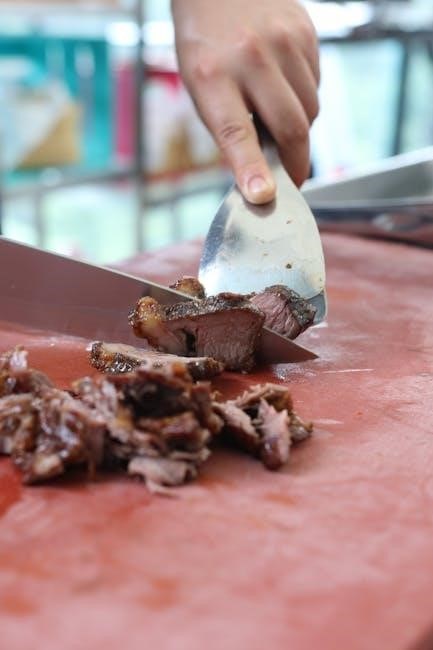
Handling and Storage of Beef
Proper wrapping and refrigeration at 40°F or below prevent contamination and spoilage. Freeze beef at 0°F for longer storage, ensuring airtight packaging to maintain quality and freshness.
7.1 Proper Wrapping Techniques
Proper wrapping is essential for maintaining beef quality. Use plastic wrap or aluminum foil to prevent air exposure, ensuring a tight seal. For longer storage, vacuum-sealing is ideal. Label and date packages for easy identification. Store in the refrigerator at 40°F or below to slow spoilage. For freezing, wrap tightly in airtight packaging to prevent freezer burn. Ensure no moisture escapes, as it can lead to ice crystal formation. Proper wrapping prevents contamination and keeps beef fresh, retaining its texture and flavor for optimal culinary results.
7.2 Freezing and Thawing Guidelines
Freezing beef requires careful preparation to maintain quality. Wrap cuts tightly in plastic wrap or vacuum-seal to prevent freezer burn. Label with dates and contents for easy identification. Store at 0°F or below for up to 12 months. When thawing, place in the refrigerator or cold water, never at room temperature to avoid bacterial growth. Allow 6-24 hours per 4 pounds for refrigeration thawing. For even cooking, thaw uniformly. Proper freezing and thawing ensure beef retains its texture, flavor, and safety, making it ready for any recipe when needed.
7.3 Maintaining Food Safety
Maintaining food safety is crucial when handling beef to prevent contamination and ensure quality. Always handle beef with clean, sanitized tools and surfaces. Store raw beef at 40°F or below to inhibit bacterial growth. Use shallow containers to prevent moisture buildup, which can lead to spoilage. Regularly inspect meat for signs of spoilage, such as off odors or slimy texture. Proper wrapping and labeling help maintain hygiene and traceability. Adhere to safe food handling guidelines to ensure your beef remains fresh and safe to consume, preserving its flavor and texture for optimal culinary results.

Advanced Beef Cutting Techniques
Advanced beef cutting involves precision skills like deboning, filleting, and portion control for even cooking. These techniques enhance meat quality and presentation, ensuring optimal culinary results.
8.1 Deboning and Filleting
Deboning and filleting are advanced techniques that require precision and skill; These methods involve carefully removing bones and cutting meat into thin, uniform portions. Proper deboning ensures tenderness and flavor retention, while filleting creates visually appealing dishes. Tools like sharp boning knives and fillet knives are essential for smooth, clean cuts. By mastering these techniques, you can achieve professional-quality results, making your beef dishes stand out. Regular practice and attention to detail are key to perfecting deboning and filleting.
8.2 Portion Control for Even Cooking
Portion control is crucial for achieving consistent results when cooking beef. Uniform cuts ensure even cooking, preventing undercooked or overcooked areas. To achieve this, use precise measurements and consistent thickness when cutting steaks or roasts; This method guarantees that all portions cook uniformly, delivering a better texture and flavor. Additionally, portioning helps in managing serving sizes, making meal planning and presentation more efficient. Always use sharp knives and cutting tools to maintain accuracy and avoid waste. Proper portion control enhances the overall dining experience, ensuring every bite is perfect.
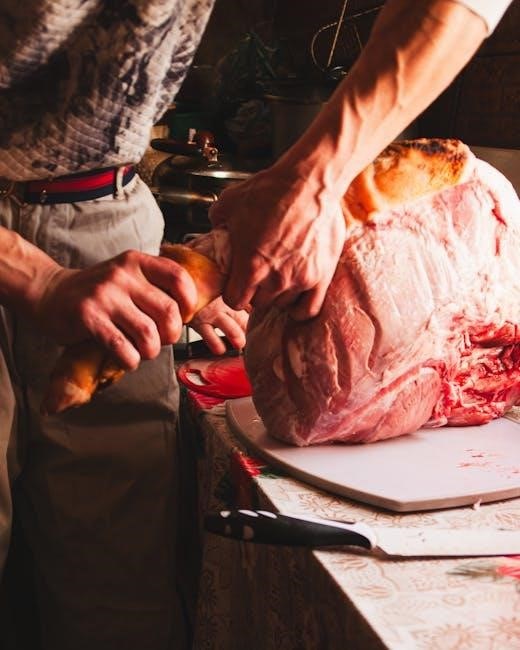
Beef Cutting for Special Diets
Cater to diverse dietary needs by selecting lean cuts for health-conscious consumers and offering organic or grass-fed options. This ensures variety and inclusivity for all preferences and requirements.
9.1 Lean Cuts for Health-Conscious Consumers
Lean beef cuts are ideal for health-conscious consumers seeking lower fat content without compromising flavor. Popular options include sirloin, tenderloin, and round cuts. These cuts are typically trimmed of excess fat and connective tissue, making them leaner and more versatile for various cooking methods. When selecting lean cuts, prioritize cuts labeled as “extra-lean” or “low-fat.” Trimming fat during the cutting process further reduces calorie content. Lean beef is perfect for grilling, roasting, or stir-frying, offering a healthy yet flavorful option for those monitoring their diet. Always ensure proper handling and storage to maintain quality and safety.
9.2 Organic and Grass-Fed Beef Options
Organic and grass-fed beef options are increasingly popular for their ethical and health benefits. These cuts are sourced from cattle raised without antibiotics or hormones, offering a more natural product. Grass-fed beef typically has a leaner profile and higher omega-3 content compared to grain-fed alternatives. When selecting organic or grass-fed cuts, look for certifications ensuring adherence to strict farming standards. Popular choices include sirloin, ribeye, and ground beef, which retain rich flavor despite lower fat content. Proper trimming and portioning are essential to enhance tenderness and flavor, making these options ideal for health-conscious and environmentally aware consumers.
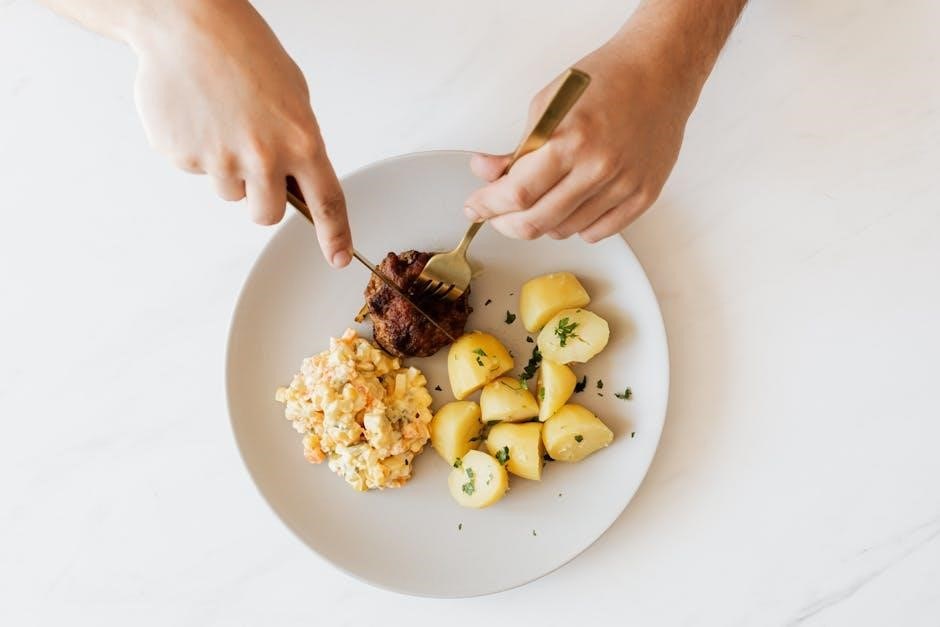
Resources for Beef Cutting Instructions
Explore online guides, tutorials, and butcher templates for detailed cutting instructions. Videos and step-by-step guides provide visual learning, while forms help customize cuts to your preferences.
10.1 Online Guides and Tutorials
Online guides and tutorials offer comprehensive step-by-step instructions for beef cutting. Websites provide detailed videos, diagrams, and written instructions to help you master various cutting techniques. Many resources cover primal cuts, retail cuts, and ground beef preparation. Tutorials often include tips on tool selection and safety practices. Some platforms also offer interactive guides, allowing you to explore different cuts visually. These resources are ideal for both beginners and experienced individuals looking to refine their skills. They ensure you can confidently guide your butcher or cut meat yourself at home.
10.2 Butcher Templates and Forms
Butcher templates and forms are essential tools for customizing your beef cuts. These documents allow you to specify preferences for steaks, roasts, and ground beef. Many templates include sections for steak thickness, roast size, and grind ratios. Forms often guide you through selecting primal cuts and portioning. They simplify communication with your butcher, ensuring your requirements are met. Some templates also include space for special instructions, such as bone-in or boneless preferences. Using these resources helps streamline the cutting process and guarantees you receive exactly what you want. They are ideal for both novices and experienced meat buyers.
10.3 Videos and Step-by-Step Instructions
Videos and step-by-step instructions are invaluable resources for mastering beef cutting. These visual guides demonstrate techniques like trimming fat, identifying grains, and portioning cuts. Many tutorials cover basic to advanced methods, ensuring learners of all levels can follow. Close-up shots and detailed explanations make complex processes clear. Additionally, step-by-step instructions often include timelines and tool recommendations. They are perfect for those who prefer hands-on learning. Videos also provide insights into professional methods, helping you achieve restaurant-quality results at home. These resources are ideal for refining your skills and exploring new cutting techniques confidently.
Concluding your journey into beef cutting, remember that proper techniques ensure safety, quality, and flavor; Mastering these skills will elevate your culinary creations. Happy cutting!
11.1 Summary of Key Points
Proper beef cutting is foundational for achieving quality and safety. Sharp knives, cutting boards, and safety gear are essential tools. Techniques like identifying meat grain, trimming fat, and marking cuts ensure consistency. Understanding primal and retail cuts, along with ground beef ratios, aids in customization. Handling and storage methods, including wrapping and freezing, maintain freshness. Advanced skills like deboning and portion control enhance results. Special diets benefit from lean or organic options. Following guides and tutorials ensures success. Mastering these steps elevates beef preparation, whether for home cooking or professional use.
11.2 Final Tips for Successful Beef Cutting
Always use sharp knives and proper cutting tools for precise results. Ensure cutting boards and safety gear are clean and ready. Follow established guides for consistent cuts and portioning. Properly wrap and freeze beef to maintain quality. Communicate clearly with butchers for custom preferences. Practice patience and attention to detail for the best outcomes. These tips will help you master beef cutting, ensuring flavorful and safe meat for every meal. Remember, skill improves with practice, so keep refining your techniques for perfect results every time.
No related posts.
Leave a Reply
You must be logged in to post a comment.